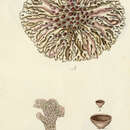Comprehensive Description
provided by Smithsonian Contributions to Botany
Parmelia congruens
Parmelia congruens Acharius, 1810, p. 491.
P. leucochlora Tuckerman in Nylander, 1860, p. 392. [Type collection: Louisiana, Hale (FH-Tuck, lectotype; US, isotype). Not P. leucochlora (Montagne) Gay, 1852, p. 152 [=Lecidea].]
P. cubensis Nylander, 1885, p. 611. [Type collection: Cuba, Wright, Lichenes cubi 76 (H, holotype; FH, K, US, isotypes).]
P. uleana Müller-Argau, 1889, p. 506. [Type collection: Morro da Nova Cintra, Rio de Janeiro, Brazil, Ule 10 (G, holotype).]
P. flavidoglauca Vainio, 1890, p. 65. [Type collection: Caraça, Minas Gerais, Brazil, Vainio, Lichenes Brasilienses Exsiccati 1301 (TUR, holotype; BM, FH, UPS, isotypes).]
P. endoxantha Merrill, 1909, p. 73. [Type collection: Sanford, Florida, Rapp (FH, holotype).]
P. bipindensis Dodge, 1959, p. 59. [Type collection: Bipinde, Cameroons, Zenker 4053 pro parte (K, holotype).]
P. zenkeri Dodge, 1959, p. 74. [Type collection: Bipinde, Cameroons, Zenker 4053 (K, holotype; L, isotype).]
TYPE COLLECTION.—North America, Swartz (UPS, lectotype).
DESCRIPTION.—Thallus closely adnate on bark, 5–10 cm in diameter, pale greenish mineral gray, often turning chamois in the herbarium; lobes sublinear-elongate, 2–4 mm wide; upper surface plane to convex, more or less maculate, rugulose to minutely pitted with age; medulla white to pale yellow; lower surface light tan to pale olive brown, rugose, moderately rhizinate, the rhizines simple, tan. Apothecia common, adnate, 2–3 mm in diameter; spores 6–8 × 7–9μ.
CHEMISTRY.—Cortex K+ yellowish (traces of atranorin and usnic acid); medulla yellowish with the color reagents (?barbatic acid, ?stictic acid, unknowns). The chemistry is complex and still not resolved. Spots are numerous and streaked on chromatographic plates. The yellowish medulla may be conspicuously developed to very pale.
WORLD DISTRIBUTION AND HABITATS.—Southern United States, West Indies, Mexico, Central America, northern South America, Congo, Angola, Madagascar; on palms, cypress, and hardwoods at low elevation (sea level to 1,200 m).
This widespread tropical species has been poorly understood, as one would surmise from the list of synonyms. The identity of the species in North America, the type locality, has never been established, and when used the name has been applied to species such as P. caperata and P. conspersa. I have typified P. congruens from a fragment in the Uppsala Herbarium, a Swartz specimen, there being no satisfactory material in the Acharian Herbarium (H). It has a light olive-brown lower surface with simple coarse rhizines and lacks cilia and soredia or isidia, four features that make identification of the species more or less unequivocal. Parmelia hypomiltha Fée is morphologically very close but has an anthraquinone in the lower medulla. Parmelia cyphellata Santesson, known from a single collection in Brazil, is apparently the isidiate counterpart of P. congruens.
Parmelia congruens is always corticolous and in Dominica occurs on sheltered cocoa palms in the northwestern part of the island.
SPECIMENS EXAMINED.—Hale collections: 2 (35636), 6 (35775), 7 (35779).
- bibliographic citation
- Hale, Mason E., Jr. 1971. "Morden-Smithsonian Expedition to Dominica: The Lichens (Parmeliaceae)." Smithsonian Contributions to Botany. 1-25. https://doi.org/10.5479/si.0081024X.4

